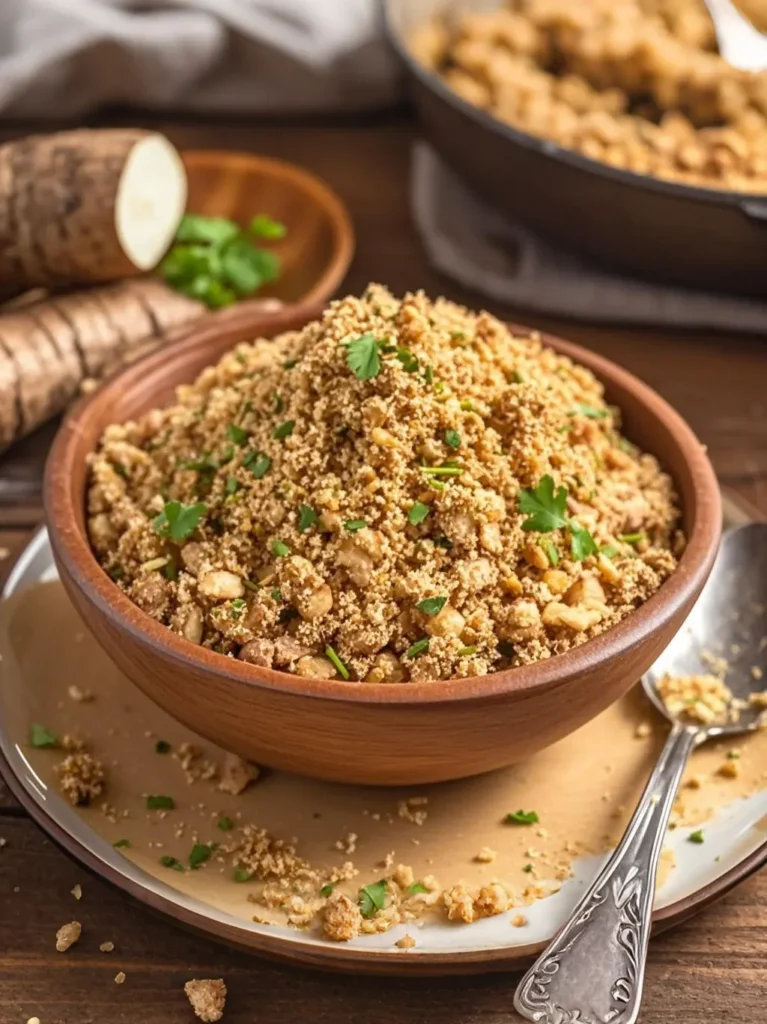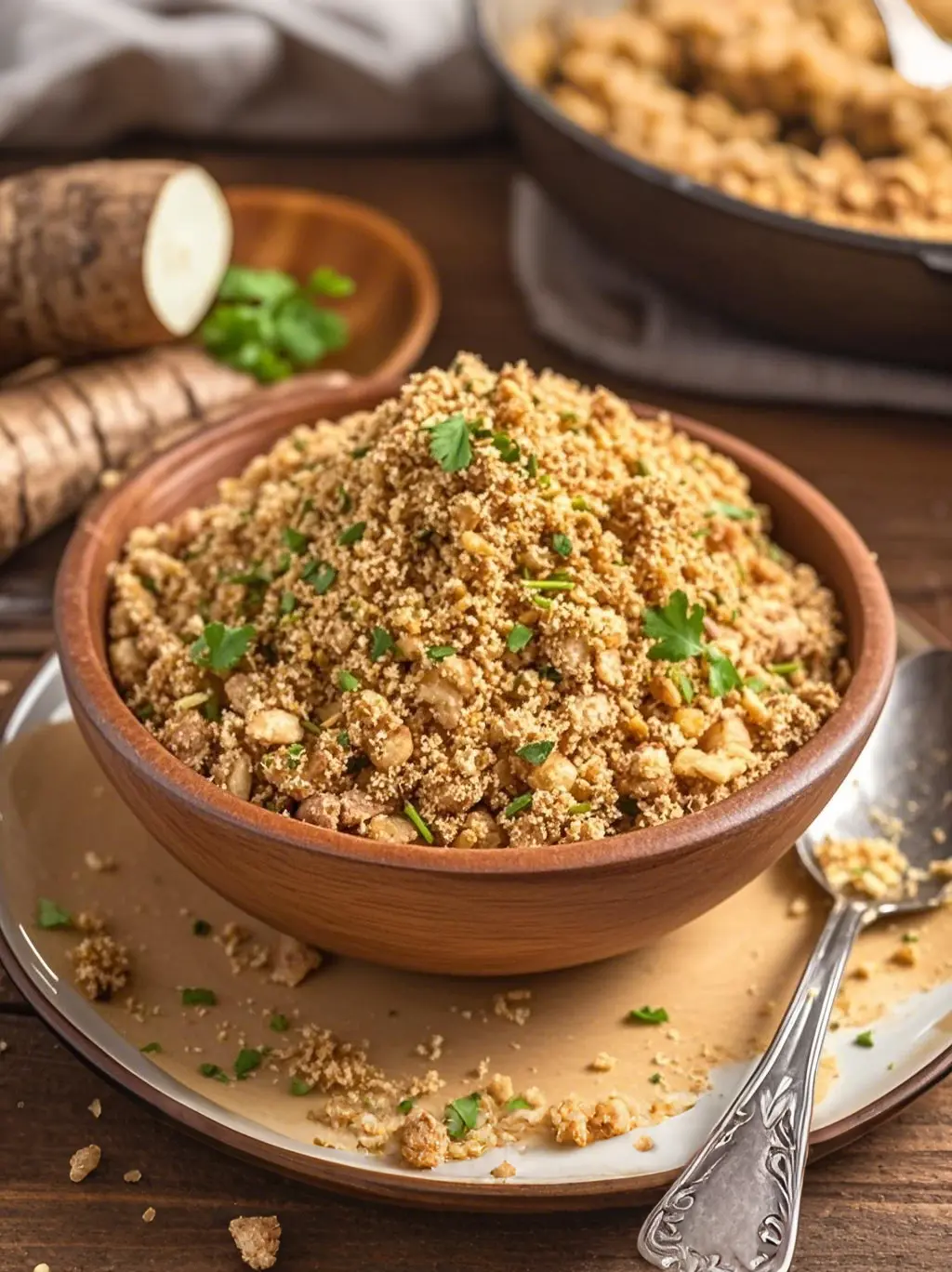Alright, food fam let’s talk farofa.
If you’ve never heard of it before, don’t sweat it. But if you’ve ever taken a bite of smoky, buttery crumbs that somehow made rice and beans better? Yeah you’ve probably had a spoonful of this Brazilian side dish without even realizing it.
This recipe is crunchy. It’s toasty. It’s rich. And it’s one of those little things that turns an everyday meal into something special.
Like, put it on grilled meat? Game-changer. Mix it with rice? Instant comfort. Toss it over eggs? Don’t even get me started.
And here’s the best part: it’s stupidly simple to make.
This guide covers everything:
- What farofa is ?
- Where it came from ?
- What it tastes like ?
- How to cook it ?
- What to serve it with (spoiler: almost anything) ?
Let’s dive into the crispy, buttery goodness of Brazil’s best-kept flavor secret.
What Is Farofa and Why Is Everyone Obsessed With It?
In the most basic terms, this recipe is a toasted flour mixture usually made with cassava flour, butter or oil, and a bunch of flavor-boosting add-ins like onions, bacon, or eggs.
But basic? It is not.
Farofa adds:
- Texture
- Flavor
- That little “what is this magic?” bite to a dish
Brazilians eat it on the side of feijoada (their iconic black bean stew), with barbecued meats, or even sprinkled on top of soups, salads, and scrambled eggs. It’s one of those “put it on everything” foods.
And for folks outside Brazil? Once you try it… it’s over. You’re hooked.

Spoiler: You’ve Probably Eaten Something Like It Before
Farofa might sound fancy, but if you’ve had:
- Southern-style cornbread stuffing
- Buttery panko breadcrumbs on mac and cheese
- Crunchy, garlicky toasted crumbs on pasta
…you’re in the right ballpark.
The texture and flavor are cozy, crispy, and savory. Like toasted breadcrumbs, but way more flavorful and nutty, thanks to cassava flour.
But here’s where this crunchy classic goes next-level: it soaks up juices like a boss. That means it doesn’t just sit on the side it becomes part of the meal.
Where Farofa Comes From: A Quick Cultural Bite
Farofa isn’t just some trendy crunchy topping it’s a pillar of Brazilian cuisine with deep roots and serious flavor history.
Let’s take a little cultural stroll (with a snack in hand, obviously).
The Brazilian Roots Behind This Crunchy Classic
Farofa was born out of practicality. Cassava (also called manioc or yuca) was a staple crop in Indigenous Brazilian communities long before colonial times. When Portuguese settlers arrived, they adopted cassava and eventually developed flour from it aka farinha de mandioca.
And what do you do when you have lots of flour and some fat?
You toast it, You flavor it, You make farofa.
Over time, it became a go-to addition in everyday meals. It’s cheap, easy to make, and ridiculously adaptable. You’ll find it in:
- Traditional stews like feijoada
- Backyard churrascos (BBQs)
- Holiday dinners
- Everyday lunches with rice and beans
It’s so loved, it even made its way into modern twists on stuffing (like in chicken dressing casseroles) and flavor-packed crumbles that show up in fusion cuisine.
Farofa’s Place in Everyday Meals and Celebrations
In Brazil, farofa shows up like ketchup in the U.S. it’s everywhere.
It’s served:
- On the side of grilled meats
- Sprinkled over black beans and rice
- In party spreads with sausage and onions
- Or layered into dishes like baked fish, meat pies, or even holiday turkey stuffing
You’ll find families arguing (lovingly) over whose farofa is better, whether it should have raisins, whether it should be buttery or oily, and if it’s “real” without bacon.
Pro Tip: Want to see how traditional comfort food gets creative in casseroles? This classic Southern-meets-Brazilian bake is packed with cozy vibes and would absolutely benefit from a crunchy farofa topping.
And yeah if you grew up with stuffing, croutons, or seasoned breadcrumbs?
This crunchy classic feels familiar but way more flavorful.
What Is Farofa Made Of? (And Why It’s So Addictive)
So here’s the real secret behind it:
It’s simple as heck… but still somehow mind-blowing.
It’s the kind of food that feels like more than the sum of its parts. When it hits your plate, you’re like, “Wait why is this so good?”
Let’s look at why.
Core Ingredients: Cassava Flour + Butter + Magic
This recipe starts with just a few pantry-friendly ingredients. The classic base usually includes:
- Cassava flour (a.k.a. farinha de mandioca)
- Butter or oil (sometimes both)
- Salt
- Maybe a little garlic or onion
That’s it. Toast the flour in butter until golden and nutty and boom, you’ve got the soul of farofa. It’s crunchy, buttery, and almost savory-sweet thanks to the cassava.
Heads up: Not all cassava flours are the same. You want toasted manioc flour (not the gummy tapioca kind used for baking). It’s dry, slightly coarse, and toasts up like a dream.
Optional Add-Ins: Meat, Eggs, Onions, and More
Now here’s where farofa turns into a choose-your-own-adventure:
- Chopped meat
- Caramelized onions
- Scrambled eggs
- Sliced scallions
- Raisins or dried fruit (controversial but it slaps with holiday meats)
- Sausage or shredded chicken
- Hot peppers (for the bold ones out there)
It’s customizable for any meal or mood. Want a vegan version? Use olive oil and skip the meat. Want it savory and rich? Load it up with egg and garlic. Want sweet holiday vibes? Try raisins and a dash of cinnamon.
Kind of like how cornbread dressing can swing sweet or savory, th’s just as flexible and just as crave-worthy.
Farofa is proof that toasted carbs, when done right, are peak comfort food.
Farofa vs Other Crumbly Sides: What Makes It Different
So you’re probably thinking:
“Okay, cool, but isn’t this just… toasted breadcrumbs or stuffing?”
Not even close.
Farofa might look like something you’ve seen before but it brings a totally different vibe to the plate. Let’s break it down.
Farofa vs Stuffing: Texture and Flavor Differences
Stuffing (or dressing, depending where you’re from) is usually:
- Soft or moist inside
- Made with bread or cornbread
- Baked in a pan or inside a bird
- Full of herbs and savory notes
Farofa, on the other hand?
- Stays dry and crumbly
- Toasted in a skillet, not baked
- Made with cassava flour not bread
- Carries a nutty, toasty, sometimes smoky flavor
Imagine a stuffing that’s never soggy, always crisp, and somehow melts into everything you eat without getting mushy. That’s farofa.
Also? You can serve it cold, room temp, or hot, and it still rocks.
Want to try a fusion of both? This chicken dressing casserole would absolutely slap with a farofa crumble topping. Just saying.
Farofa vs Grits or Polenta
This one’s kinda apples to oranges but folks still ask.
Grits and polenta are creamy corn-based porridge dishes. They’re soft, spoonable, and usually buttery.
Farofa is:
- Toasty
- Chewy-crunchy
- Cooked dry, not wet
- Used more like a sprinkle or mix-in not as a base
Think of it as a topping or flavor finisher, not the main act. It’s like the Parmesan crisp of Brazilian food small but mighty.
Why does stand out?
Because it’s:
- Fast
- Versatile
- Naturally gluten-free
- Comforting AF
- And yeah… crunchy in the best way
It’s the side dish that turns a good meal into a complete one.
How to Make Classic Farofa at Home
This isn’t one of those 40-step, stress-you-out recipes. Farofa is chill. It’s quick. It’s forgiving. And you don’t need a pantry full of random ingredients to make it work.
Step-by-Step Recipe for Beginners
Here’s your basic farofa game plan:
Ingredients:
- 1½ cups toasted cassava flour (look for farinha de mandioca or farinha torrada)
- 3 tablespoons butter (or oil for a lighter/vegan version)
- 1 small onion, finely chopped
- Salt to taste
- Optional: garlic, chicken bits, scrambled egg, herbs, or hot sauce
Instructions:
- Heat a large skillet over medium heat.
- Melt butter (or heat oil), then sauté onion until soft and golden.
- Optional: Add chopped garlic, chicken, or other add-ins here.
- Add cassava flour, stirring constantly so it toasts evenly.
- Keep stirring for 5–8 minutes, or until the flour turns golden and smells nutty.
- Season with salt. Done. Serve hot or room temp.
Pro tip: Stir often and don’t walk away cassava can burn quick.
Cooking Tips That Make It Taste Like the Real Deal
- Use a wide skillet so the flour gets toasted, not steamed
- Go low and slow medium heat max
- Add extras at the right moment: eggs after toasting, chicken before
- Don’t drown it in butter you want crisp, not soggy
It’s super similar to dry toasting breadcrumbs except it stays light, fluffy, and way more satisfying.
Kind of like how you prep a good baked sweet potato pie it’s all about timing and patience, but once you nail it? You’ll crave that flavor constantly.
Want to batch it? You totally can. Just store in an airtight container for up to 5 days and re-toast gently before serving again.
Farofa Recipes to Try Right Now
Ready to level up your dish-game? Here are three killer ways to make it your own.
Farofa with Turkey and Caramelized Onions
Why it hits: Salty, rich, and savory-sweet.
What you need:
- Toasted cassava flour
- Butter
- Onion (caramelized low and slow)
- Crispy chopped turkey
- Garlic, salt, and black pepper
Toast the cassava after cooking the turkey and onions in the same pan. Let all that flavor soak in.
Sweet Farofa (Yep, It’s a Thing!)
What? Farofa for dessert? Yep and it’s so good with grilled fruits.
What’s in it:
- Cassava flour
- Coconut oil or butter
- Brown sugar
- Cinnamon
- Shredded coconut or raisins (optional)
Serve it over roasted bananas or grilled pineapple. Chef’s kiss.
Farofa for Vegans: Oil-Based, Fully Plant-Based Version
How to build it:
- Use olive oil or avocado oil
- Skip the meat, and use sautéed onions, garlic, and herbs
- Add roasted peanuts or toasted pumpkin seeds for crunch
Tons of flavor, no animal products. This one holds its own at any BBQ.
How to Eat Farofa (Because It’s Not Just a Side Dish)
This stuff’s like the hot sauce of carbs it goes on almost everything.
What to Serve With It: Meats, Beans, BBQ, and Beyond
Farofa is the BFF of:
- Grilled steak, chicken, or sausage
- Feijoada (Brazilian black bean stew)
- Grilled veggies and tofu
- Roasted root veggies or sweet potatoes
It’s especially on anything saucy it soaks up juices like a pro.
Can You Use Farofa on Salads, Eggs, and Soups? Heck Yes.
Farofa on top of:
- A simple egg scramble? Game-changer.
- Buttery soup? Adds crunch.
- Green salad with citrus dressing? Unexpectedly amazing.
It’s like croutons, but more flavorful and gluten-free.
Store-Bought Farofa: What to Look For (and Avoid)
No time to make it from scratch? You’ve got options but read those labels.
Is Packaged Farofa Any Good? The Honest Take
Some are great. Some taste like dust.
Look for:
- “Farinha de mandioca torrada” on the label
- Butter or oil already mixed in
- No preservatives or weird extras
Brazilian Brands to Try if You Can’t Make Your Own
- Yoki
- Hikari
- Kitano
You can find them online or in Latin/Brazilian grocery stores in the U.S.
How to Store Leftover Farofa Without Losing the Crunch
Short-term: Store in an airtight container at room temp for up to 5 days.
Long-term: Freeze it in a zip bag and toast lightly before serving again.
Avoid moisture like the plague crunch is key.

Classic Brazilian Farofa Recipe
Ingredients
Equipment
Method
- Heat a large skillet over medium heat. Add butter or oil.
- Add the chopped onion and sauté until soft and golden, about 3–4 minutes.
- If using garlic, chicken, or other add-ins, stir them in now and cook briefly.
- Stir in the cassava flour. Cook, stirring constantly, for 5–8 minutes until golden and nutty.
- Season with salt to taste. Serve hot or at room temperature.
Nutrition
Notes
Tried this recipe?
Let us know how it was!Conclusion:
Farofa is one of those low-key foods that punches way above its weight.
It’s cheap, quick, customizable and it makes everything on the plate better.
Whether you go classic, vegan, or dessert-style, it’s about to become your new favorite sidekick.
Give it a shot once… and you’ll wonder where it’s been your whole life.
LET’S STAY CONNECTED! FOLLOW ME ON:
Tried this recipe? I’d be thrilled to see your take on it! Snap a pic and tag me @Sweftyrecipes so I can share your delicious creations with our foodie community.
→ FACEBOOK | INSTAGRAM | PINTEREST
FAQs: Answers to Your Farofa Questions
Is farofa-gluten-free?
Yep! Cassava flour is naturally gluten-free. Just check labels if you’re buying packaged farofa to make sure there’s no wheat added.
Is farofa healthy?
In moderation, yes. It’s made from cassava flour and often toasted in butter or oil, so it’s calorie-dense but can be part of a balanced meal especially with lean protein and veggies.
Where can I buy farofa in the US?
Look for Brazilian grocery stores or international markets. Online shops like Amazon and Latin food stores often carry brands like Yoki or Hikari.
What is Brazilian farofa made of?
Traditional Brazilian farofa is made of toasted cassava flour, butter or oil, and often includes onions, garlic, bacon, or eggs. It’s dry, crunchy, and savory.
How do you eat farofa in Brazil?
Brazilians eat farofa as a side dish with feijoada, grilled meats, rice and beans, or even sprinkled on top of eggs and salads. It’s a daily staple in many homes.
Is farofa similar to couscous?
Not really. Couscous is soft and steamy, made from wheat semolina, while farofa is dry and crunchy, made from toasted cassava flour. They serve different roles on the plate.
